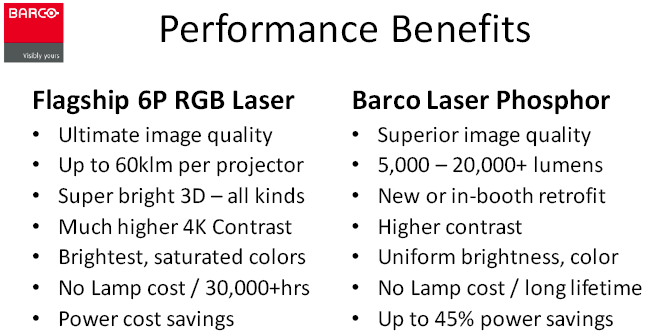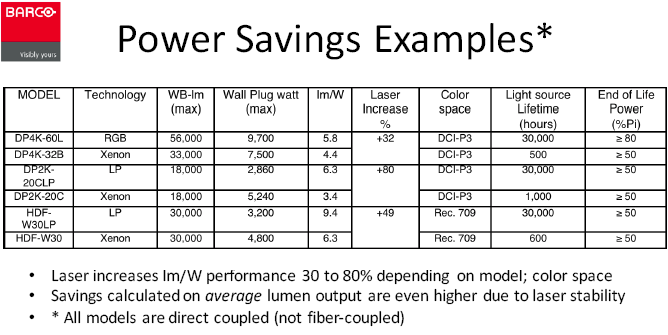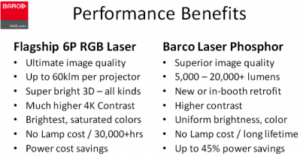
Bill Beck returned as a representative of his employer, Barco, to talk about laser cinema going mainstream.
He started by saying that all Premium Large Format (PLF) cinemas would be dominated by Laser RGB, because of image quality, operation simplicity and total cost of ownership (TCO). Laser Phosphor will also do well and that will mean lasers throughout the cinema world.
The development of laser for cinema started really around 1995. From 2003 to 2008, ‘quiet’ prototype development continued, but DCI standards were developing and speckle was a challenge as laser sources were limited. Later, there was a focus on very high brightness, with Barco developing 50K+ lumen projectors and Imax developing a system for 70mm film screens.
By 2014, Barco and Christie introduced cinema projectors based on laser at CinemaCon and Barco installed its first 6P projector. In 2015, others started to jump in and Barco sold units for for ‘exhibitor-branded’ PLF whle Imax rolled out upgrades in giant screens.
Dolby entered with Christie OEM projectors and NEC introduced Laser Phosphor (LP) for smaller cinemas
2016 – “The rocket takes off”, said Beck. Barco passed 100 screens and Imax accelerates, while Dolby has done a deal with AMC. Barco introduce a LP line with 18K “20CLP” NEC has extended its line up and new laser and laser engine suppliers have entered the market.
The first all-laser multiplexes have been deployed. The first cinema circuit to announce all laser – not a multiplex, but a full chain – has gone public, so this year laser really is rolling out.
More LP models will be adopted (and we heard at the event that 30K P3 projection engines have been developed).
Direct laser works well because of etendue, which enables better coupling between light sources and the optics and imagers. Better 3D is possible because of the narrow bandwidth of direct laser projectors.
LP technology extends downwards and can be used for retrofit to some existing projectors. RGB Laser is for the top venues, especially with very large lasers.
 Beck went through the benefits of laser and laser phosphor
Beck went through the benefits of laser and laser phosphor
Use cases for flagship RGB projection for “exhibitor-branded” PLF screens. Lasers are ideal for large 3D screens of 30 metres or above. The experience is that laser projectors have a very long life. Beck said that the DP4K-60L has seen a sub-1% drop in brightness in the first year.
“Laser patrons will attend laser theatre more often and pay higher ticket prices”, Beck said. An exhibitor (Santikos) in Texas will support an 18 screen multiplex with all laser projectors.
Beck then looked at fibre vs direct delivery. Barco tried a lot of fibre solutions, he said, but decided it was better to move the cooling outside the projector, rather than the complete light source. This solution gave the highest wall plug efficiency. On fibre delivery, it’s a bit early, he believes. There are still dangerous cables outside the box and although fibre may be low cost, ‘pigtailing’ the fibres is not free.
Looking at the decision of single vs dual chassis, single is simpler and easier with quickest installation and maintenance as well as smaller footprint and better image quality.
Wall plug efficiency is good because you can get better lumens/watt than with lamps, as you only get the energy you need. Tighter etendue also means better efficiency in the optical system.

Beck and Barco believe that you should spend money on the cooling – you are effectively buying lumen hours/watt. He showed a table of 32-80% power savings with different technologies (using Barco models)
Going back to its range, Barco has four 6P premium laser projectors and will add more in the LP space to offer a full range for cinemas.
In questions, Beck clarified that he had no objection to fibre on safety, when it’s properly done (as it is by Christie, for example, with clever interlocks), but if it’s done by others and badly, it could cause problems for the whole world of laser.
Beck said that if wide colour gamut (WCG) becomes, effectively, mandatory, then RGB laser might take over. Green laser remains a problem and challenge, but LP demand will drive blue laser costs down a lot because of the increase in laser volume manufacture. Chinnock said that there could be a lot of money going into RGB laser in cinema.

